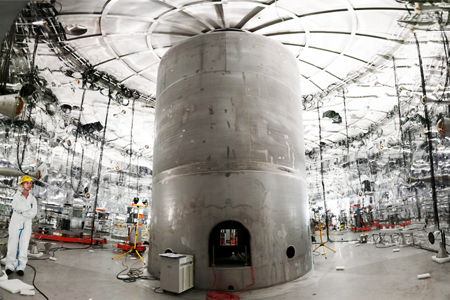Aspera Newsletter (January/February 2011)
A new experiment to explore the elusive neutrino properties has been inaugurated last November at INFN Gran Sasso National Laboratories. GERDA is searching for a very rare phenomenon which would confirm that the neutrino is a Majorana particle, meaning it is identical with its antimatter brother, the antineutrino.
|
Being the most widespread particles in the Universe, neutrinos recover a fundamental role in determining the evolution of our Universe. But exploring their properties is a real challenge as they are also the most elusive particles reaching the Earth from the Cosmos, interacting only rarely with matter. Facing this hard adventure is anyway a worthwhile investigation in the world of particles, as neutrinos seem to be very peculiar. In particular, some theoretical models hypothesize that the elusive uncharged neutrino could coincide with its antimatter particle, the anti-neutrino, usually referred to as a Majorana particle. “If this unusual property were confirmed it would explain why neutrinos are so much lighter than their charge leptonic partners (electron, muon and tau particles)” said Stefan Schönert, spokesperson of GERDA. “Moreover, it would shed light on the fundamental question why today’s Universe is dominated by matter and not antimatter. The search for neutrinoless double beta decays therefore does not only probe elementary particle physics theory, but also our knowledge concerning the structure of the entire Universe”. The questions about whether neutrinos and antineutrinos are identical particles will be studied in a new experiment which was inaugurated last November at the INFN Gran Sasso National Laboratories. GERDA (Germanium Detector Array) is searching for a very rare phenomenon concerning neutrinos, a process that could be detected by the study of the decay of the nuclei 76Ge. Only if the neutrino particle coincides with the antineutrino, the double beta decay phenomenon without neutrino emission can occur. Two of the neutrons inside of the 76Ge nucleus are transformed (decay) simultaneously into two protons, two electrons and two neutrinos. However, in the case of neutrinos and antineutrino they are the same particle, the neutrino is exchanged as a virtual particle amongst the two decaying neutrons and, therefore, does not emerge from the nucleus. As a result, only electrons would be released which deposit energy in one of the germanium crystals. Weighing neutrinos Besides the question of whether the neutrino is a Majorana particle, the observation of the double beta decay without neutrino emission would permit physicists to directly measure the effective mass of the electron neutrino, the value of which has a great impact on Universe development models. |
(Credit: GERDA Collaboration) GERDA operates bare germanium detectors enriched in the isotope 76Ge submerged in about 70 m3 liquid argon cryostat which in turn is surrounded by a water tank. The apparatus is set in the rooms of Gran Sasso National Laboratories, under a 1400-meter high mountain in the heart of Italy. The spontaneous decay of matter that GERDA is searching for is so rare that it is like perceiving a single specific note during a concert season; a room with perfect acoustics is needed to hear it. In GERDA the detectors are used at the same time to produce and reveal the particles emitted during the decay. Each of the eight detectors – sized as a beverage can and weighing about two kilograms each – is made of high-purity germanium mono-crystals, a semiconductor material, enriched in the isotope 76Ge. When a 76Ge nucleus decays, the emitted electrons deposit their energy in the germanium detector. To avoid external disturbances, the crystal detectors are suspended in the cryostat, a six meter tall and four meter wide tank, filled with liquid argon (at a temperature of –186 °C). The cryostat, in turn, is placed inside a water tank with about ten-meter diameter, which serves as a further shield. The “acoustics” of the GERDA experiment are guaranteed by the liquid argon, water and rock volumes, placed in this nesting-doll structure, which protect the typical “note” of the experiment from billions of particles arriving from the Universe, but also from the Gran Sasso rocks. These disturbance “sounds” are blocked out by the rock above the laboratory, and finally by the “nesting dolls” which protect the experiment. GERDA is an international collaboration with institutes from Belgium, Germany, Italy, Poland, Russia and Switzerland. After an initial period of commissioning the experiment with natural high-purity crystals, the enriched detectors will be deployed and the physics data taking will start in early 2011. Submitted by Francesca Scianitti (INFN / Italy)
& the GERDA Collaboration GERDA’s website: Download pdf version: Download the whole issue |
